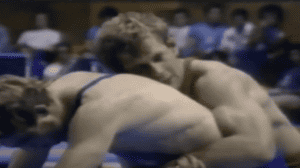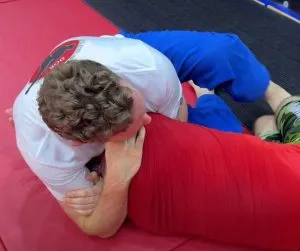There are hundreds of grappling styles practiced around the world, some are hugely popular like Freestyle Wrestling, Judo and Brazilian Jiu-Jitsu while others may not be so popular largely due to the fact they are more region specific cultural styles such as Shuai Jiao, Romanian Tranta, Georgian Chidaoba and Azeri Kurash.
Although there are many similarities that grappling styles have there are many differences and the difference generally comes from the rule set and purpose that the grappling style is based upon. Most grappling styles were developed out of the need for defending oneself, training troops and in some cases sport. As the years passed there was more of an emphasis on sport than actual combat and thus we have seen many interesting grappling styles arise due to the specific rulesets that they abide by.
Some grappling styles demand grabbing a certain grip on the opponent’s belt such as Korea’s Ssireum while others use a Gi and are more suited to ground combat such as we see in BJJ. Some styles rub oil all over their body as we see in Turkish Oil Wrestling – Yagli Gures, while some styles allow opponents to only grab from above the waist such as in Greco-Roman Wrestling.
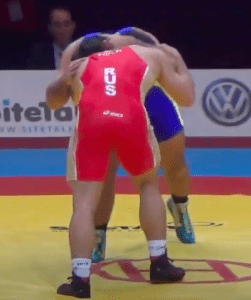
All Grappling styles will develop certain attributes due to the above mentioned rule sets and when going into combat, these attributes will come into play. We see this in modern MMA where it is not unusual to see BJJ practitioners submit their opponents, Samboists use smooth transitions to throw opponents into a submission and Wrestlers being able to control where the fight ends up as well as dominate the clinch and ground and pound elements of the sport of MMA.
Although all grappling styles have attributes that can be carried into other styles as well as combat, in the past years one grappling style has really dominated with MMA as well as been a very big contributor to the success of athletes within other grappling styles.
The grappling style we are speaking about is Wrestling, which to be specific can be either Freestyle Wrestling, Greco Roman Wrestling or Folkstyle Wrestling. All 3 of these styles of wrestling share the same attributes for the most part and are often misunderstood when non-wrestlers try to add elements of wrestling into their grappling style as most non-wrestling only focus on the techniques and not the the attributes that are required in wrestling such as pressure and proper body movement in contrast to your opponent’s position.
What is Wrestling Pressure
Wrestling pressure can simply be explained to the non-wrestler as using distance, movement, contact, proper limb placement, distraction, scrambling for position, proper weight distribution on the opponent, making the opponent carry your weight, offsetting balance of the opponent and controlling hip level when in direct contact with the opponent all together in unison in order to control the specific situation you are in.
This wrestling pressure is what high level wrestlers use to set up and complete wrestling techniques as well as this is the most important yet overlooked aspect of wrestling when trying to learn wrestling for other grappling arts.
A very important thing to note when speaking about wrestling pressure is the fact that there are 2 specific rules in wrestling that indirectly promote wrestlers developing wrestling pressure. The first is the passivity rule (passicity call) where wrestlers get punished for being passive in the match. Passivity is when a wrestler avoids contact, does not place effort to attack, tries to avoid any type of grip/clinch, avoiding wrestling, running away, blocking out and grabbing the hands or fingers of the opponent. This passivity rule paves the way for action, as wrestlers are now forced to wrestle, to clinch, to attack and not to stall. The passivity rule sets the environment for wrestler’s developing pressure as they simply cannot stall and must develop action.
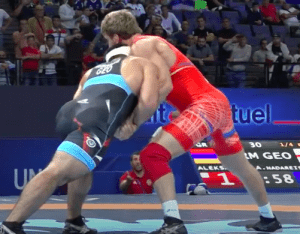
In many grappling arts especially Brazilian Jiu-jitsu, it is very common to see 2 BJJ practitioners, standing and afraid to commit or place pressure for the takedown as well as when on the ground (due to the ruleset of BJJ) it is common to see someone stall in one position for the entire match due to point advantage. It must be noted that a lot of the fear to engage and place pressure is due to the fact that submissions are allowed and there is the ability for a person to jump to guard. Even with the fact that BJJ’s ruleset is very specialized, BJJ athletes will certainly appreciate adding wrestling pressure, wrestling ability and wrestling’s attribute set into their BJJ skill set.
Another contributor to the development of wrestling pressure is the push out rule where if a wrestlers pushes another wrestler out of bounds in the wrestling match (basically outside the wrestling circle are that the match is held within) the wrestler will be awarded a point, a change of passivity call or awarded a certain advantageous starting position upon next restart in the match. This push out rule makes stalling very difficult, especially combined with the passivity rule.
We can see many of the attributes of these 2 rules carry over into modern MMA where it is common to see wrestlers dominating the cage, the clinch and the overall fight speed and rhythm, all because they are always in a state of controlling the pressure of the fight.
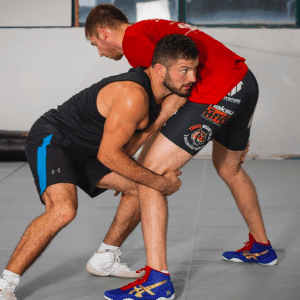
Wrestling pressure is even more than that, we can see it in the clinch where there is constant pulling and pushing motion, moving side to side, changing strong grips, snapping the head down while moving in changing directions to attack. We see wrestling pressure from chest to chest positioning in the over under clinch (as well as proper shoulder positioning), we see it in hip contact when fighting for finishing the arm drag, we see it when using proper head pressure on a duck under, we see it from constant attacking and not being afraid of being unsuccessful in the attack as there is the element of chain wrestling and the scramble.
This type of pressure in wrestling is the most common thing that is not taught when grapplers coming from outside wrestling try to learn wrestling and it is the most important thing when trying to properly teach wrestling for grapplers as once they understand how to use and deal with wrestling pressure, their wrestling game will improve 100 fold.
What is The Wrestling Pocket
The wrestling pocket is a very interesting term, as it is not similar to the boxer’s pocket, to the Judoka’s pocket or to the pocket that is spoken so much about during UFC fights.
The wrestling pocket is absolutely related to pressure but with a constant understanding of body placement and weight distribution in contrast to body contact. Sounds confusing, doesn’t it? Well it really is not confusing once you understand wrestling pressure.
A great example of the wrestling pocket can be seen in the ever so loved arm drag.
Many wrestling coaches notice 2 things when watching other grappling styles try to teach the arm drag, and that is 100% going to be the hip positioning and weight distribution of the person doing the arm drag in comparison to the opponent.
Let’s take a Nogi BJJ practitioner. Generally they have wonderful setup and execution of the arm drag until a certain point where that is where they would try to grab the opponent’s far hip to catch the back (standing up). The big difference is that they are generally not taught how to use the wrestlers pocket properly here as generally their hip position in comparison to the opponent is too high and they are not making the opponent carry their weight.
A proper example of this can be seen watching any proper Greco Roman Wrestling or Freestyle Wrestling arm drag in competition where you will always see the proper hip height and placement as well as guaranteed weight distribution being used on the opponent.
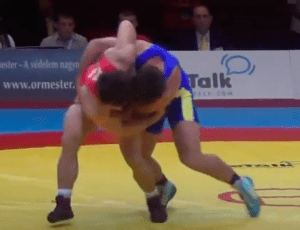
This is the wrestler’s pocket, this is where the real difference between knowing an arm drag and being able to do an arm drag at all levels is. Basically the wrestler’s pocket is when you have all elements of a technique, distance and weight distribution plus wrestling pressure and timing in your favour to maximize the techniques effectiveness.
Does this mean that all Brazilian Jiu-jitsu competitors perform poor arm drags, no it doesn’t, in fact you have BJJ athletes who have world class arm drags such as Marcelo Garcia, Marcus “Buchecha” Almeida, Roberto “Cyborg” Abreau and Gary Tonon all using arm drags at the level of a proper international class wrestler. This has to be stated as in no means are we trying to downplay BJJ, what we are trying to emphasize is development of Wrestling pressure and understanding the wrestlers pocket in order to skyrocket a grapplers wrestling abilities and thus their overall grappling game.
How to Train Wrestling Pressure
It’s a simple question with a simple response. You need to wrestle under the ruleset of wrestling as it’s going to be very hard to attain wrestling’s attributes without training in the ruleset.
Now this is not to say that you need to only train under wrestling’s ruleset as you will still have your purpose for learning wrestling. You may be a BJJ athlete getting ready for a local grappling tournament and need to develop aggressiveness and takedowns but be a great guard player with great guard submissions so of course you need to develop that as your premier ability with wrestling as a secondary ability. In this specific case, wrestling’s ruleset (when training wrestling) will still develop attributes that are great to have. Training with passivity calls, pushouts, scrambling for top position and fighting off the pin (yes fighting off the pin) are all going to develop that wrestling aggression and non-stop attack style that we see winning a majority of all major grappling competitions whether it be BJJ, EBI, ADCC and Naga.
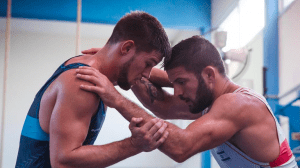
The trick is to keep focused on the rule set you are training for but taking the wrestling attribution development without developing bad habits that you will get from wrestling under wrestling’s ruleset. If you are asking if it can be done, the answer is a big YES.
ADCC and IBJJF champion Marcus Buchech Almeida is great proof that training wrestling under wrestling’s ruleset can truly develop a better total grappling game. Buchecha has been training wrestling for many years now and this shows in his aggressive takedown game, his outstanding scrambling ability, constant wrestling pressure and use of the wrestling pocket as well as overall aggressiveness shown during his matches. The most impressive element is that Buchecha has truly become a great wrestler while not carrying over bad habits that could impact his overall BJJ and Submission Wrestling game.
The proof is in the pudding and this is why we are starting to see grappling schools install a proper wrestling program over a takedown program in their grappling school program. It is because the ruleset of wrestling combined with the techniques of wrestling develop the athletic attributes of wrestling.
In Conclusion
Wrestling pressure and the use of the Wrestling pocket are the most often underlooked yes most important factor to properly adding wrestling into your BJJ and grappling game. It is not easy to develop and takes time but once you understand wrestling pressure and use of the wrestling pocket, your grappling and BJJ abilities are only going to get much better. We see this as many top IBJJF, ADCC and MMA athletes are dedicating a large part of their training to wrestling and those who do it properly are winning.
At the end of the day, grappling styles are just a type of wrestling under a certain ruleset that develops attributes in order to dominate under the set of rules the grappling system has.
When speaking of wrestling, specifically the Olympic wrestling style as well as collegiate folkstyle wrestling, we see that these are very specific attributes that really can make a difference to a grappling athlete’s ability and confidence when properly added.
So get on the mats and start wrestling today, you only have to gain from it.


